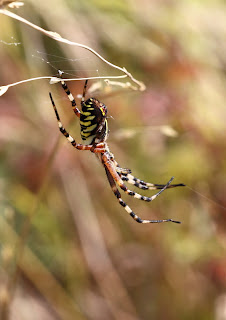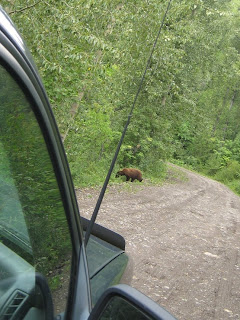This will be a very mixed bag of photos from the last few days, covering a rather wide range of habitat (and indeed the UK)!
Thursday morning saw me, John and Vince departing from Newquay on a pelagic organised by Steve Rogers, a Cornish birder - he'd advertised the trip on his blog, and we'd jumped at the chance to try something different. Given the recent glut of Wilson's Petrels from the SW Approaches, western Ireland, and several in north Cornish waters from similar trips, this was definitely the target species, but as with all pelagics, you just don't know what's out there until you start looking! The weather forecast was also very good, with only a very light breeze and sunshine throughout the day... rather different to the very Scillonian trip last year where most people were seasick in choppy conditions!
Our skipper for the day was Chris Lowe, owner of the
Atlantic Diver. This proved to be an excellent boat for the purpose, a really fast catamaran, and with easy viewing for the 12 birders all around. We reached our destination 20 miles offshore in just under an hour, leaving us loads of time to chum, and to watch. At one point we spotted a trawler with a large group of attendant seabirds in the distance, but given the boat's speed we could get over there to check things out very quickly and easily.

To cut a long story short, we didn't see as much as we'd hoped for, though! A Sooty Shearwater showed well behind the trawler, the Balearic shown above drifted around with us for much of the day, and I guess we saw approximately 50 Storm Petrels (though very hard to get precise numbers on these). Despite our best efforts, we just couldn't find a Wilson's. Skuas were represented with a single Arctic and a Bonxie.
Anyway, nothing ventured, nothing gained! I think these type of pelagic trips off mainland Cornwall have definitely got considerable potential, and they're certainly cheaper than a trip to the Scillies. As already mentioned on the net, the most difficult part of the package to organise is good, effective chum for seabirds. Chris was used to chumming for sharks, but compared to the foul concoction used on the Scillonian this didn't seem to result in a significant oily slick on the surface, and we never really had decent number of Stormies in view simultaneously. Perhaps a more liquid mixture is required, but I certainly wouldn't claim to be an expert...



To see some much better photos from the trip, take a look at
Steve's blog - recommended!
Friday was back at work, followed by a quick dash out to the lovely Canvey Island with JL for a juv Kentish Plover. We knew the odds were against us, since the bird had been found over high tide, but had then moved out onto the mudflats as the water dropped. On arrival, waders were scattered thinly over a huge area, so we just scanned through as many birds as possible in the limited time available. Fortunately Jono found the bird, albeit at considerable distance, and reasonable views were obtained at 60x in the clear evening light.
Saturday morning started with some butterflies, at Colley Hill near J8 of the M25. My target here was Silver-spotted Skipper, one that I've never seen before. We eventually found about 10-15 of these fast-flying little insects on the lower slopes of the SE side of the hill, though none posed particularly well for photos. A single worn Chalkhill Blue was also seen here, and I couldn't resist photographing a couple of lovely fresh Commas.

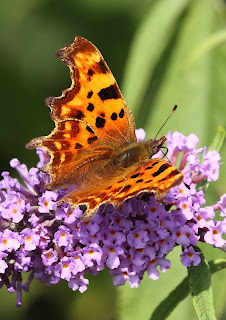
The afternoon was back at Canvey, hoping for better views of the plover together with a small group of local birders. Sadly, this wasn't to be, but we did see good numbers of Med Gulls (including numerous juvenile birds, as photographed) and a few Black and Little Terns.


In the evening, the birding pace slowed as everyone went into socialising (AKA drinking) mode at a birders' BBQ hosted by Martin and family. This involved lots of quality banter, some appalling double entendres (which I've fortunately forgotten), general piss-taking of year-listing twitchers (who could they be?!).... and some moth trapping! The highlight was definitely a Red Underwing (photo courtesy of Hawky, in a rare sober moment), while the other photo is a Grey Dagger... probably.
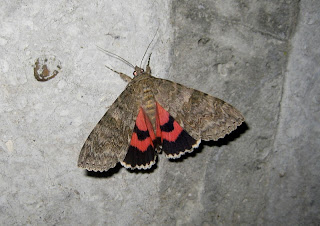
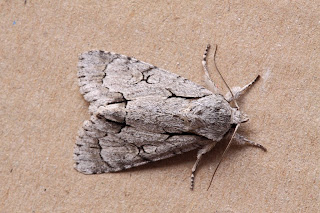
Finally, I spent this morning at Rainham, largely prompted by news of a Sabine's Gull heading upriver past Tilbury. However, the gull wasn't forthcoming, so I switched to a spot of spider photography - an obvious move, really. Here are some Wasp Spider photos - attractive and impressive beasts!
